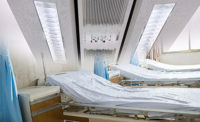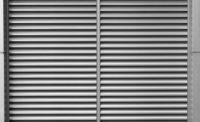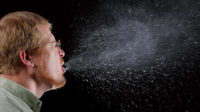Air is the primary carrier of heat, moisture, contaminants, and airborne pathogens in patient rooms, isolation rooms, and operating rooms. Temperature levels and contaminant concentrations in patient rooms depend on how the supply air is distributed within the space. Such distribution of supply air and the resulting temperature levels determine the thermal comfort, air quality, and potential for transmission of airborne pathogens in the room.
The airflow patterns, temperature distribution, and concentration of contaminants including the flow path of airborne pathogens in a patient room can depend on several factors. The factors include the location and type of supply diffusers, supply air flow rates (air change rates), associated diffuser throws, supply air temperature, size and locations of the room return, bathroom exhaust flow rates, locations and strengths of various heat sources in a room, arrangement of furniture, and other obstructions to airflow, and relative location of the patient in the room. In addition, orientation of the room can determine the solar sensible heat loads in the room that can affect the airflow patterns.
Physical testing and measurements of all these parameters in a real-life situation is time-consuming and labor-intensive if not impossible. In such situations, Computational Fluid Dynamics (CFD) simulations become an attractive alternative to analyze and optimize the performance of HVAC system configuration with real-life scenarios.
VIRTUAL PATIENT ROOM
In this study, a virtual patient room is created to understand how the locations of return diffusers can affect the airflow patterns, temperature distribution, and the probable flow path of airborne pathogens in a patient room. A three-dimensional CFD model of a patient room is shown in Figure 1. It shows the location of the patient, caretaker, seating area, door to the corridor, door to the bathroom, and supply and return air locations for the two different HVAC configurations. The room contains heat-generating equipment including lighting, monitor, infusion pump, television, computer, and two occupants — the patient and the caretaker. The room also has a south-facing window that adds into the sensible heat load due to solar heat gain. The total sensible heat load in the room is assumed to be 16 Btuh/ sq ft (50 W/m2).
The air is supplied through three single-slot (1 in) linear diffusers each 4 ft long. The two linear diffusers placed on the drop ceiling are facing the window and directed towards the window whereas the linear diffuser over the patient is designed to supply the air at an angle directed towards the room. The room was assumed to operate under slightly negative pressure with the exhaust flow from the bathroom exhaust fan. The supply airflow rate is maintained at a total of six air changes per hour. The probable flow paths of airborne pathogens are analyzed by tracking the path of airflow emerging from the patient’s face.
VALUABLE INSIGHTS
These analyses provided valuable insights into the three-dimensional airflow patterns, temperature distribution, the resulting thermal comfort and, more importantly, about the probable flow path of airborne pathogens. Thermal comfort of occupants was analyzed by employing the Predicted Mean Vote (PMV) index as described in ASHRAE 55 standard for thermal comfort. As shown in Figure 1, a total of two cases were analyzed for two different locations of the return air grill.
As shown in Figure 1a, in the base case analysis both the supply diffusers and the return grill are located near the ceiling. The linear supply diffuser is located right above the patient’s head. As shown in Figure 2a the air exiting from this diffuser forms a strong recirculating pattern above the patient. The exiting air jet from the linear supply diffuser creates strong entrainment (induction) flow over the patient and behind the bed. As a result the air flows upward over the patient and gets entrained back into the supply air stream.
The airflow patterns shown are at one specific plane, which passes through the center of the patient’s body. However, the airflow patterns resulting from various arrangements of the supply and return diffusers in the room are quite complex which in turn can affect the airflow pattern. Figure 2b shows resulting air temperature distribution indicating slightly higher air temperature near the patient’s head behind the bed compared to the temperatures near the opposite wall. This is partly due to the flow of the return (entrained) air passing through this region. Figure 2c shows the resulting distribution of the PMV, the thermal comfort index, which varies from -3 degrees (too cold) to +3 degrees (too hot).
PMV values of 0 indicate a thermally comfortable environment which is indicated by green color in Figure 2c.
As shown in this figure at the 4-ft (1.2 m) height from the floor, the occupant thermal comfort is at neutral level (PMV close to 0.0). However, as indicated by the flow pathlines in Figure 2d, strong entrainment flow can cause the airborne particles (pathogens) from the patient’s face to entrain back into the supply air stream above, and then, can eventually spread into other locations in the room. It shows the supply diffuser becomes a means to entrain and spread the pathogens into the room.
Ideally, the supply air after exiting the diffusers should pass over the patient and return back to the return grill through a single pass without entraining back into the supply air stream and without mixing with the room air. Air induction principle is successfully employed in the design of active chilled beams where the air jets from the linear diffusers cause strong entrainment of the room air forcing it back into the return grill.
On the same principle, the initial base case configuration is modified by increasing the size of the room return and moving it behind the linear diffuser over the patient’s head (Case 2, Figure 1b). In both the cases, the supply diffusers and return grill are located near the ceiling. As shown in Figure 3a, relocation of the return grill right behind the linear supply diffuser provides ready access for the return air to exit from the room. It should be noted that the size of the return grill is also increased in this arrangement to facilitate easy passage of the return air.
Also as shown in Figure 3b and 3c, such modification does not significantly change the temperature distribution and resulting thermal comfort of occupants in the room as compared to the base case configuration. However, as shown in Figure 2d, it can significantly alter the flow path of the airborne particles. It clearly shows such a configuration can potentially provide a single pass flow over the patient and can reduce the probability of entrainment of the airborne particles back into the supply stream. Though part of the return air still can get entrain back into the supply air stream, most of the airborne pathogens can find a clean return path back to the return grill without any obstructions. This arrangement can also reduce the probability of deposition of airborne pathogens on surfaces in the patient room.
SUMMARY
A virtual patient room was created with the help of CFD models to evaluate the effect of various HVAC design configurations for two different locations of the return grill. These analyses provided valuable insights into airflow patterns, temperature distribution, thermal comfort of occupants, and (very importantly) the probable path of airborne particles (pathogens) in a patient room.
These analyses indicate the linear diffusers can cause strong recirculation and entrainment (induction) flows in the room. Depending on the location of the room return, the airborne pathogens released from the patient’s face can get entrained back into the supply air stream and can eventually spread into the entire room. However, placement of the room return behind the linear supply diffuser over the patient’s head can potentially provide a single-pass flow path to airborne particles without significant recirculation and entrainment back into the supply stream.
Note that a combination of locations and type of supply diffusers, locations of the room return, and supply airflow rates can affect the airflow patterns, which are quite complex and specific to a particular design configuration. Therefore, it is difficult to reach any general conclusions about the optimized design configuration and placement of supply diffusers and return grills in a patient room. However, this study demonstrates CFD analysis can be an effective tool in gaining the insight and optimizing the design of air distribution systems in healthcare faculties. Such efforts can help in designing patient rooms with better occupant thermal comfort along with the best possible hygienic conditions. ES
REFERENCES
Kishor Khankari. 2013. “Role of HVAC System Configuration on Probable Flow Path of Airborne Pathogens in a Patient Room.” ASHRAE Annual Conference, Denver, June 2013. Conference Paper DE-13-C019






